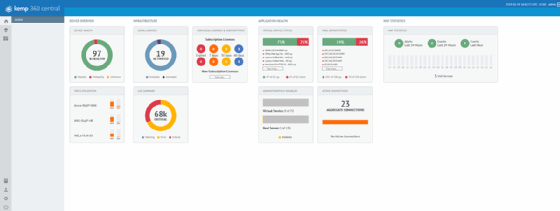
Sergey Nivens - Fotolia
Kemp 360 Vision analyzes F5, Nginx data
The latest version of the Kemp 360 Vision service can apply predictive analytics to data taken from F5 Networks and Nginx load balancers.
Application delivery controllers have evolved into significant components for providing performance and security services to applications running on enterprise and cloud data centers. Over the last couple of years, the makers of ADCs have built support in their management suites for products from rivals and open source groups.
This week, ADC maker Kemp Technologies expanded the data sources for its 360 Vision predictive analytics service to include the on-premises load balancers of rivals F5 Networks and Nginx. Kemp 360 Vision is a SaaS application that identifies potential problems within ADC services and suggests remediation steps.
In general, the last feature is for customers that need "to maintain a multivendor ADC ecosystem," said Jason Dover, the head of Kemp's product strategy. A financial institution, for example, could have legacy applications "highly embedded with F5 devices and there's no real impetus" to move it.
Shamus McGillicuddy, an analyst at Enterprise Management Associates, said "enterprises definitely need something like this, and we've seen similar moves from other vendors."
"F5 has invested a lot in orchestration and analytics," he said.
How Kemp 360 Vision works
Using 360 Vision requires installing on hypervisors a virtual machine agent that gathers syslogs, SNMP data and other information through the APIs of load balancers and ADCs. Each agent has rules and logic for delivering to customers "first-level analytics," Dover said.
More advanced problems get sent to the SaaS application for stage-two analytics, Dover said. If a problem is detected, 360 Vision can send an alert via its user interface, email, text message or Slack.
The data collection piece of Vision is similar to that of other ADC vendors. The product's differentiator is how the software correlates the information to identify problems and suggest corrective action, Dover said. Kemp is working on using machine learning to improve its analytics.
The importance of analytics depends on the number of ADCs deployed in an environment and the applications in front of them, said Kevin Tolly, founder of The Tolly Group, based in Boca Raton, Fla. The Tolly Group is a provider of IT testing and validation.
"For smaller businesses that run an ADC just to have some redundancy and a little better performance, basic analytics might suffice," Tolly said. "For others that need to have very fast and consistent interaction with their customers [such as an e-commerce site] the requirements will be much higher."

Automation added to 360 Central
Along with expanding the data sources for analytics, Kemp added to its ADC management console, called 360 Central, automated deployment of load balancers on VMware's hypervisor. In the next couple of months, the company plans to add hypervisor support for KVM and cloud providers AWS and Microsoft Azure.
Deploying lightweight load balancers close to applications running on a variety of platforms is a concept that's become necessary as companies increasingly spread workloads across data centers and hybrid and public clouds.
"As opposed to consolidating many workloads behind a single large physical appliance, customers are more interested in deploying greater volumes of lightweight instances just for the expressed purpose of individual applications and services," Dover said.







